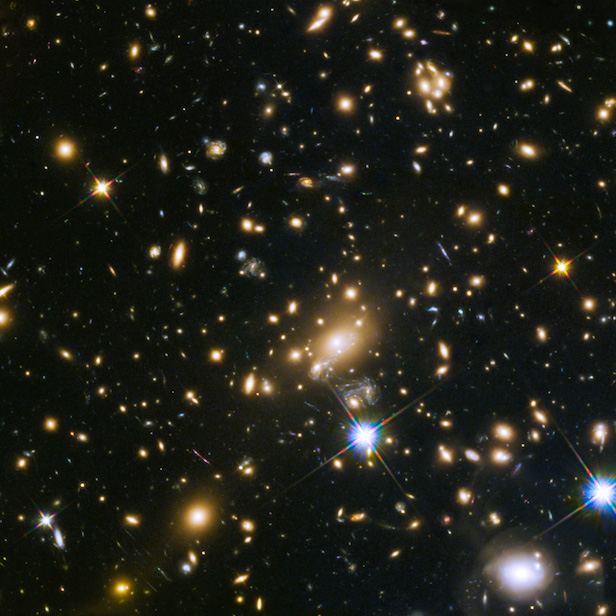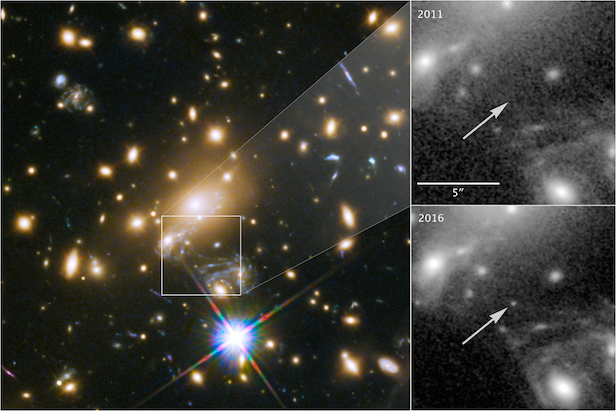Hubble spots the farthest star ever seen
This massive blue star existed just 4.4 billion years after the Big Bang

The light from the galaxy cluster MACS J1149.5+223 took five billion years to reach the optics of the Hubble Space Telescope. Image credit: NASA/ESA/S. Rodney/FrontierSN team/T. Treu/P. Kelly/GLASS/STScl
The most distant star has been spotted from more than halfway across the universe. The light from the enormous blue star, officially named MACS J1149.5+223 Lensed Star 1, but nicknamed ‘Icarus’, would never normally have been seen, even with the help of the world’s largest telescope. However, thanks to the help of a natural phenomenon known as ‘gravitational lensing’, NASA/ESA’s Hubble Space Telescope was able to detect the light from a star roughly nine billion years away, from a time when the universe was just 30 per cent its current age. These results will provide much needed information in the never-ending battle to understand dark matter.
As a result of Icarus’ discovery, studying individual stars through the medium of gravitational lensing provides rare and unique information about the foreground galaxy cluster, as well as how the most luminous stars evolve.
“This is the first time we’re seeing a magnified, individual star,” explains Patrick Kelly of the University of Minnesota. “You can see individual galaxies out there, but this star is at least 100-times farther away than the next individual star we can study, except for supernova explosions.”
Gravitational lensing is an interesting cosmic concept. It consists of a hefty foreground galaxy cluster bending the light of a more distant star due to its great gravitational strength, much like how regular lenses work. This amplifies the light of the background star in the process. Sometimes the light from a background object can also appear as multiple images.
In the case of Icarus, the foreground galaxy cluster was MACS J1149.5+223, which is located roughly five billion light years away from Earth. In order for gravitational lensing to properly occur, the galaxy cluster must sit very precisely in between Hubble and the distant galaxy that contains the massive star. With the combination of Hubble’s exceptional resolution and the great strength of the galaxy cluster’s gravitational lensing effect, astronomers can see and study Icarus.
Kelly and his team, including Jose Diego of Instituto de Física de Cantabria, Spain, and Steven Rodney of the University of South Carolina, observed Icarus’ brief illumination as its brightness shot up by 2,000 times its true brightness when it was briefly magnified.
Models have suggested that this tremendous brightness increase was contributed to by further ‘gravitational microlensing’ of a compact star at least three-times the mass of our Sun, also in the foreground galaxy cluster. Without this additional lensing star, the brightness would usually reach about 600 times its usual brightness.
The team of researchers were originally using Hubble to monitor a distant supernova in a spiral galaxy. In 2016, the researchers noticed a new point of light not far from the magnified supernova. Based on the position of this peculiar point of light, they inferred that it should be much more highly magnified than the supernova.

Icarus was only visible due to the unusual, yet spectacular nature phenomenon known as ‘gravitational lensing’. Image credit: NASA/ESA/P. Kelly (Uni. Of Minnesota)
After using Hubble again for spectroscopic analysis of the distant light, it was discovered that this was a blue supergiant star. Compared to our Sun, this type of star is significantly larger, more massive, hotter and possibly hundreds of thousands of times brighter than our Sun. However, even this doesn’t mean we should be able to see its light at this incredibly large distance without the help of gravitational lensing.
But why did the team not think it was just another supernova? “The source isn’t getting hotter; it’s not exploding. The light is just being magnified,” says Kelly. “And that’s what you expect from gravitational lensing.”
By detecting the amplified light of a single background star, astronomers were allowed a unique gateway of understanding into the elusive nature of dark matter in galaxy clusters. This unseen material contributes to roughly 25 per cent of the entire universe.
The probing of material surrounding the foreground galaxy cluster allows one theory to be tested, and that’s whether dark matter is primarily made up of a huge number of primordial black holes formed in the birth of the universe with masses of ten-times larger than that of the Sun. The results did not match the hypothesis, as light fluctuations from the background star, monitored by Hubble for 13 years, would have looked much different if there was the presence of intervening black holes.
When NASA’s James Webb Space Telescope (JWST) is eventually launched, astronomers expect to find more stars like Icarus. With its extreme sensitivity in the infrared section of the electromagnetic spectrum, the JWST will bring unprecedented detail to even the faintest light, making the discovery of magnified stars a more common occurrence.
Keep up to date with the latest reviews in All About Space – available every month for just £4.99. Alternatively you can subscribe here for a fraction of the price!




